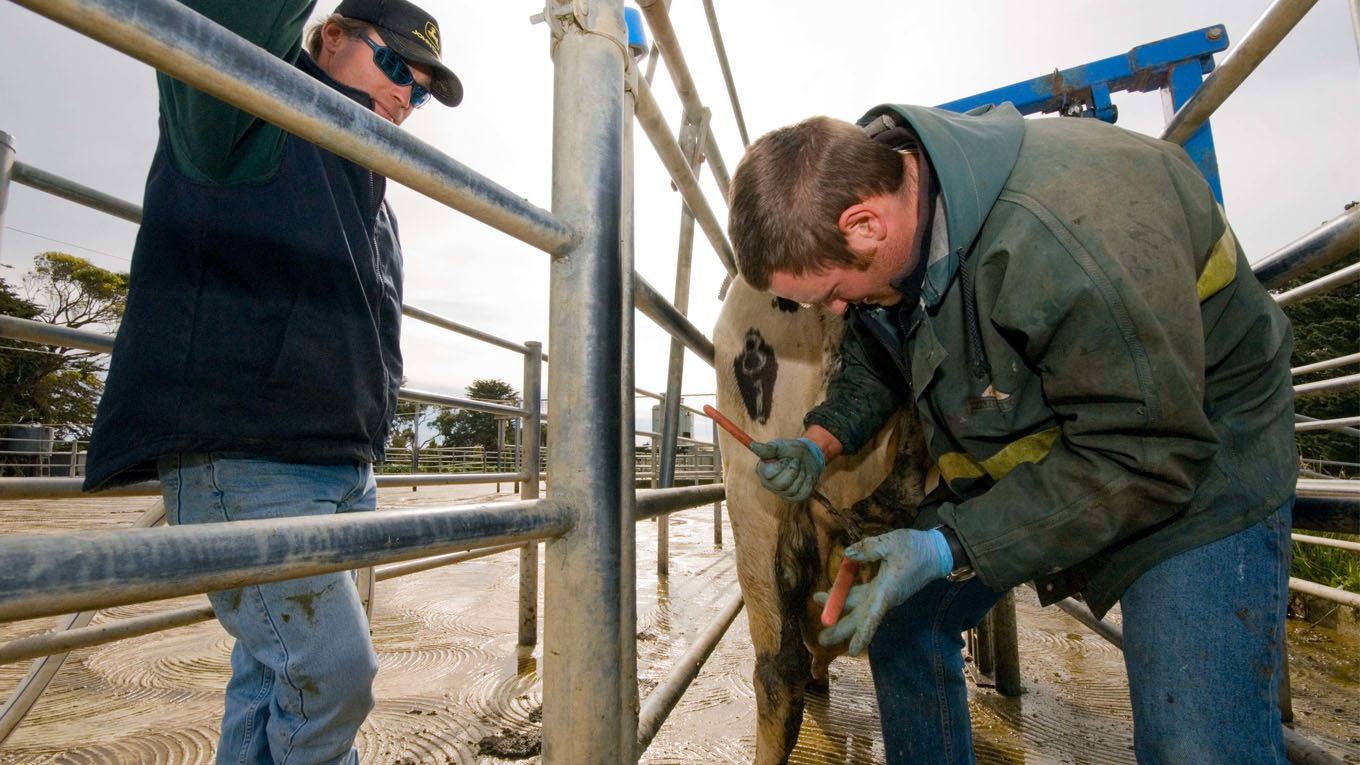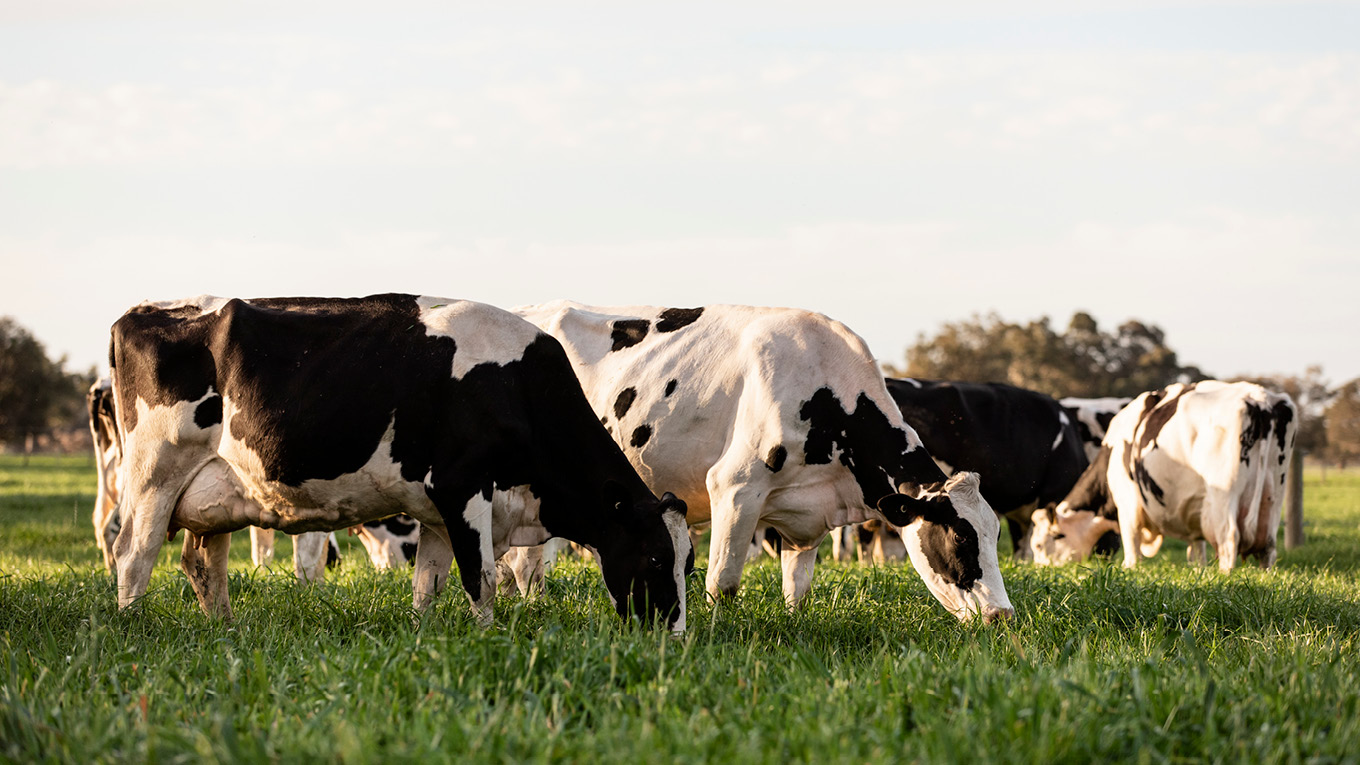Lameness
Identifying and addressing lameness in dairy cattle is an essential part of both animal management and farm business management. The prevention, early detection and treatment of lameness improves animal welfare by minimising suffering and distress in cows.
There are three important things for farmers to remember when it comes to lameness in cows:
- Act decisively
- Treat quickly
- Check regularly
The complete guide to preventing and managing lameness can be used to help farmers manage lameness on-farm.
It can be difficult to identify causes of lameness and make changes to reduce the number of cows becoming lame. Understanding the risk factors is critical. Multiple risk factors may contribute to a lameness problem.
The key risk factors influencing numbers of lame cows within Australian dairy herds are:
- Stockmanship – human actions altering the normal walking behaviour of the herd
- Poor dairy shed entrance and/or exit design slowing cow flow
- Rough surfaces and long walking distances contributing to excessive wear or trauma to hooves
- Herd management, such as:
- Nutrition – feed and nutritional supplements
- Management in wet conditions – use of standoff areas
Lameness in dairy cows usually comes from an injury or disease affecting the hoof or leg. However, lameness can also occur alongside specific illnesses that are unrelated to the hoof or leg. These can include:
- Clinical mastitis
- Clostridial infections
- Septicaemia and associated conditions
- Neurological conditions
- Arthritis
- Cellulitis and trauma leading to an infected wound
Dairy farmers looking to learn more about managing lameness in practical environment should consider attending one of Dairy Australia's Healthy Hooves workshops, which are held by regional teams in each dairy region.
If you'd like to learn more about lameness in a practical environment, come along to a Healthy Hooves workshop in your region.
Alternatively, download Dairy Australia's Lameness field guide to keep or share with on-farm staff.
Identifying lameness
Before identifying lameness, it is important to know what a healthy hoof looks like.
What does a healthy hoof look like?
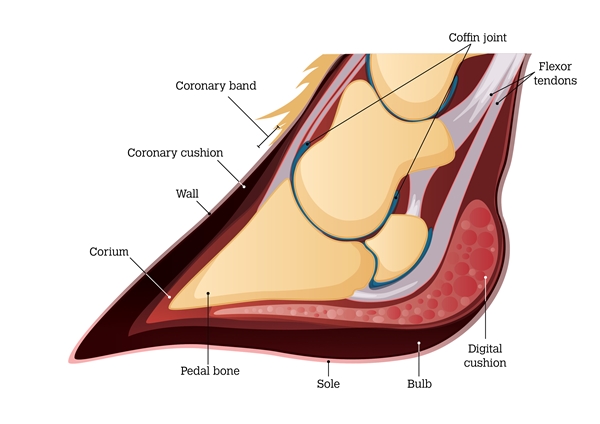
Coronary band
Joins the hoof and the skin. The pale, hairless band.
Wall
Grows from the coronary band downward at a rate of approximately five millimetres per month. Made of tough horn.
Pedal bone or distal phalanx
Connects with other bones in the hoof to give the hoof flexibility. Tendons allow the bone to move forwards and backwards in normal movement. Protected by the digital cushion and corium.
Sole
Grows down directly from beneath the pedal bone. This horn is softer than the wall horn. The sole is joined to the wall by the white line.
Bulb
Merges with the inside and outside wall and the sole continuous with the coronary band. A soft, rubbery part of the hoof.
Digital cushion
Acts as a shock absorber, bearing the weight of the cow as she steps onto her foot.
Coffin or distal interphalangeal joint
Allows the hoof to flex. Prone to injury involving the attachment of the deep flexor tendon to the pedal bone. The tendon can separate and the toe of the claw will turn up.
Corium
Supports the pedal bone within the hoof wall.
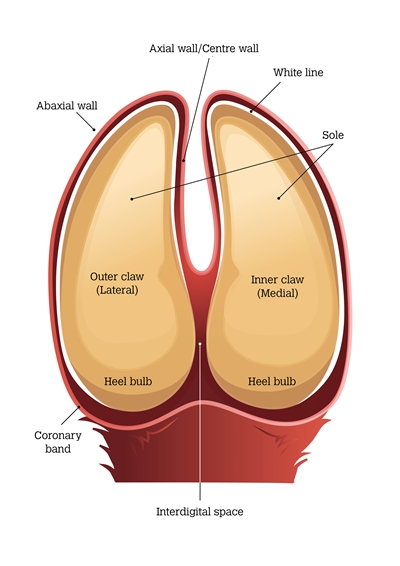
Heel bulb
Merges with the inside and outside wall and the sole. A soft, rubbery part of the hoof continuous with the coronary bulb.
Inner claw (medial)
Controls direction and carries more weight than the outer claw in front hooves. In the front hooves the inner claw is slightly larger.
Outer claw (lateral)
Controls direction and carries more weight than the inner claw in rear hooves. In the hind hooves the outer claw is slightly larger.
Interdigital space
The space between the inner and outer claws. This space can become impacted with debris, which can lead to damaged skin and subsequent infection.
Coronary band or coronet
A pale, hairless band at the junction of hoof and skin. Area at the top of the hoof from where the hoof wall is produced.
Wall – axial or centre and abaxial or outside
Grows downward from the coronary band approximately 5mm per month. Made of tough horn.
White line
Junction where sole meets hoof wall. Runs from the bulb of the heel to the toe and then back along the first third of the inside wall. Softer than the wall and sole. It is a point of weakness and often the site for wedged stones and entry of infection.
Sole
Sole horn is softer than the wall horn.
How to identify lameness
This video explains the process of examining a lame cow.
This video explains the indicators of lameness.
Lameness scoring
A lameness scoring scale has been created by Dairy Australia to help farmers measure the severity of lameness within their herd. It should be done on a regular basis to identify cows going lame early.
The Dairy Australia Lameness scoring chart can be used to help measure and identify the severity of lameness in the herd.
How and when to lameness score
- Scoring should occur at least once a month
- It should be done at a time when the whole herd can be assessed. Ideally this can be done as the cows are walking out of the dairy after milking
- Score cows on an even, hard, non-slip surface. Look at the foot placement, arching of the back and bobbing of the head to determine the level of lameness
Record how many cows are score 0 and 1
- Any cow that is a score 2 or 3 should be recorded and cut out for treatment as soon as possible
Benefits of regular scoring
- Monitors the effectiveness of a lameness prevention plan
- Allows prompt detection and treatment of lame cows
- Improves cow comfort, herd health and milk production
This video explains how to lameness score.
Lameness cost calculator
The cost of lameness to a farm business can be significant, especially around calving time. It is important to understand the economic impact lameness can have in terms of veterinary expenses, lost milk production and effect on calving patterns.
The Lameness cost calculator can assess the effect of lameness on a farm.
Treating lameness
Quick and effective treatment is essential to managing lameness. All of the following information is included in the Lameness field guide - management and treatment on the go – a short, step-by-step manual to assist farmers in the treatment of lame cows.
Principles of treating claw lesions
This video explains the principles of treating claw lesions.
Before examining the lame cow for treatment, it is important to have the necessary tools to hand. The animal needs to be secured as safely and comfortably as possible. Having some assistance while carrying out treatment is a good idea.
Treatment tool kit
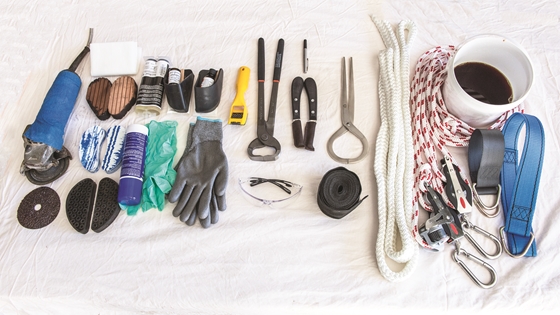
Essential:
- Hoof knives - 1 x right handed, 1 x left handed
- Hoof knife pouch (old teat-cup liner)
- Hoof tester
- Hoof trimmer
- Straps or pulley for lifting leg
- Soft rope for securing foot
- Back bar or rope or support belt for cow
- Antiseptic spray
- Cowslips or blocks
- Sharpening stone
- Diamond hoof knife sharpener
- Fine round chainsaw file
- Glove or wrist protector
- Disinfectant
Optional:
- Pairing hoof knife, rasp or angle grinder with sanding disc
- Antibiotic (if indicated and under veterinary supervision)
- Methylated spirits
Knife sharpening

Step 1: Correct angle
When a knife is first purchased, use a rough stone, a file or an angle grinder to change the inner angle (straight and curved cutting edge) of the blade to 20 degrees. The knife edge should be equally tapered.
Always sharpen the inside edge of the knife.

Step 2: File the edge
Use a fine chainsaw file, a fine grain stone or diamond hoof knife sharpener. File the sharpened edge again.
Ensure consistent angle.

Step 3: Protect the blade
Protect the blade while not in use inside an old teat-cup liner, piece of polythene tubing or leather cover.

Step 4: Sharpen regularly
Touch the blade up regularly with a diamond sharpener. When sharpening a knife, have it securely held to ensure a consistent and sharp edge.
Watch this video on knife sharpening.
Treatment facilities
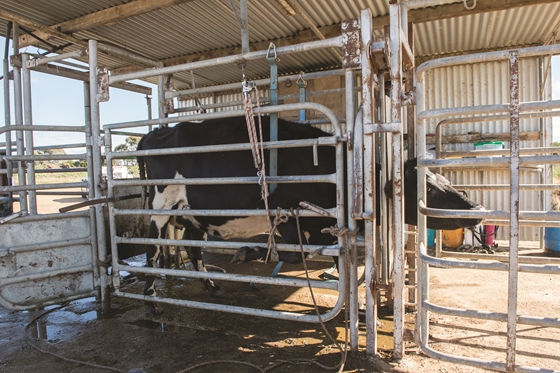
Farms should have appropriate facilities for treating lame cows. Good facilities make it easy to provide prompt treatment and ultimately improve lame cow management.
The health and safety for both cow and operator are important aspects of any treatment facility.
How to restrain a cow
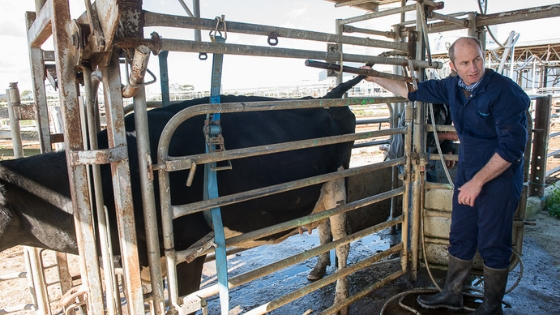
Step 1
Get an assistant to 'tail jack' the cow by gripping the tail near its base and lifting it up and forward over the cow's spine. This can help prevent the cow from kicking when applied correctly.
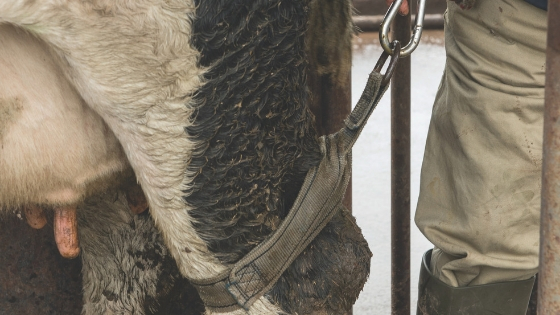
Step 2
Pick up the lame leg.
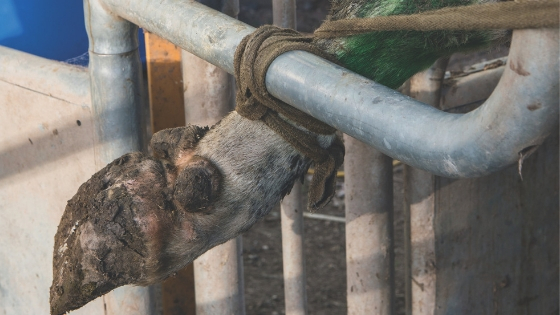
Step 3
Using a quick release knot, secure the leg to the rail. Have an assistant hold the rope, rather than tying it.
Be aware. If a cow drops to her knees with her head in the bail, this may put pressure on her windpipe, suffocating her. Putting a strap or belt under her chest can prevent this.
Watch this video to learn leg lifting techniques.
How to apply a block or cowslip
A block or cowslip goes on the good claw, not the injured claw.
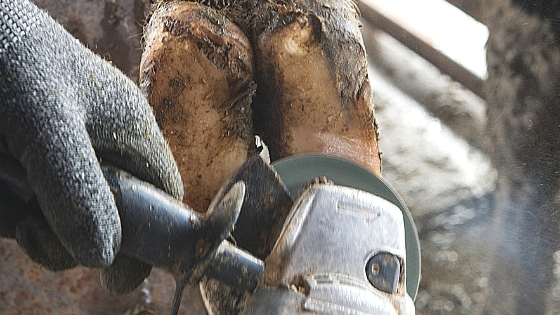
Step 1
Clean the foot thoroughly. Then, using a paring knife, scrape the sole and wall clean. An angle grinder with a sanding disc may be used.
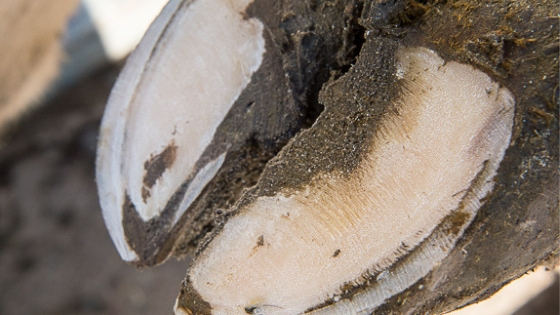
Step 2
Dry the foot with methylated spirits or a hairdryer.
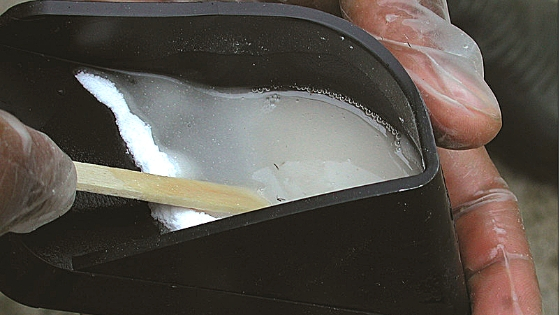
Step 3
Check the block or cowslip for size. If necessary, cut the block or cowslip and then refer to glue-mixing instructions.
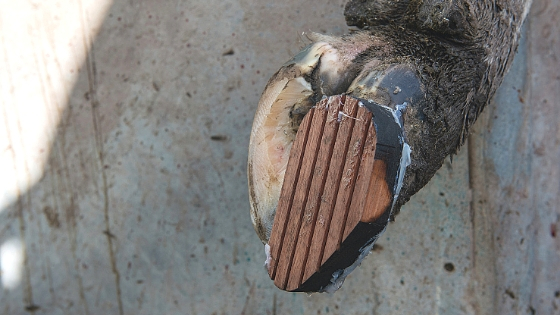
Step 4
Apply the block or cowslip onto the healthy claw and allow the glue to dry.
Remember to record the lame cow treatments on the DataGene website.
Watch this video on applying a block:
Treating lesions
White line disease
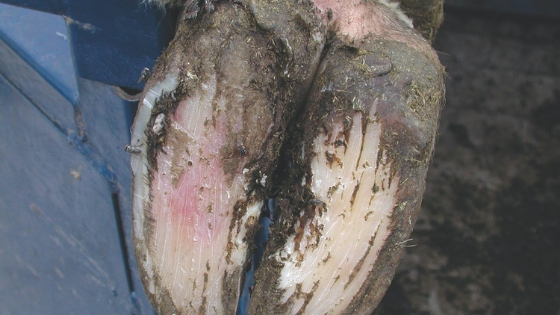
White line disease is the separation of the wall of the hoof from the sole. The following could indicate white line disease:
- Break out or abscess at the coronet (top of the claw) may occur
- Wall is split away from the sole and the space between them may be filled with sand or gravel
- If both front feet are affected, a cow may stand and walk cross-legged
- When side wall is trimmed, a dark line can be found running vertically up the hoof from the sole sometimes to the coronet
This video explains how to treat white line disease.
Axial wall crack
An axial wall crack is a crack on the inside of the toe at the join of the hoof wall and sole. The following could indicate an axial wall crack:
- A vertical crack on the inside of the claw
- Crack starts at the coronet (interdigital skin/axial wall junction) and grows down towards the sole
- A pain response may occur if the hoof testers are used to squeeze the inner (axial) wall against the outer (abaxial) wall
- A small area of proud flesh might be visible under the dark, gravel-filled cavity
- The wall is under-run upwards towards the interdigital skin and down to the sole
This video explains how to treat an axial wall crack.
Footrot
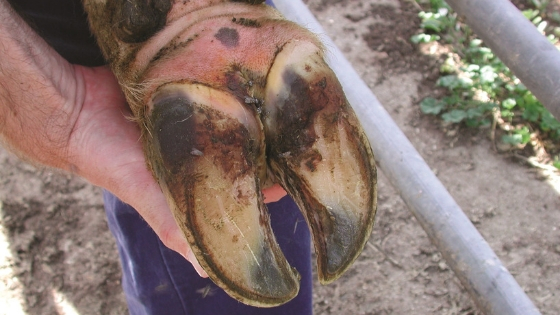
Footrot is a bacterial infection with a putrid smell found between the claws. The following could indicate footrot:
- Skin between claws is broken
- Swelling and heat between the claws
- It often smells
- Often occurs in wet conditions
- Common to find a stone or stick between the claws
This video explains how to treat footrot.
Digital dermatitis
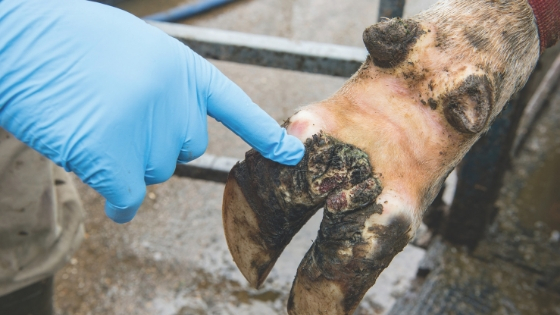
Digital dermatitis (sometimes known as hairy heelwart) is the infection of the digital and/or interdigital skin with erosion and initially painful ulcers, which become chronic and less painful but can still be infectious.
It is the most common cause of lameness in cows in the world. Until recently, it was not thought to be a problem in Australia, but recent studies in Victoria and Queensland have shown that it is present in a larger proportion of herds than was previously thought. Digital dermatitis was found to be present in 32.2% of cows sent to a knackery and lab tests showed that the bacterial populations in the lesions were similar to those found elsewhere in the world.
The following could indicate digital dermatitis:
- In its early stage, it looks like a raw grey/brown ulcer at the back of the foot. Cleaning with water reveals the red surface of the ulcer.
- These ulcers then develop into warts. Some of these may extend beyond the claws.
- The infection may get deeper into the hoof, causing erosion and under-running of heel horn, especially if left untreated.
- Eventually the ulcer or wart may appear to heal naturally or shrink, but may still be a source of infection to other cows.
- Painful to begin with, causing 'shifting' lameness. Less or no pain as it becomes chronic.
Sole injury
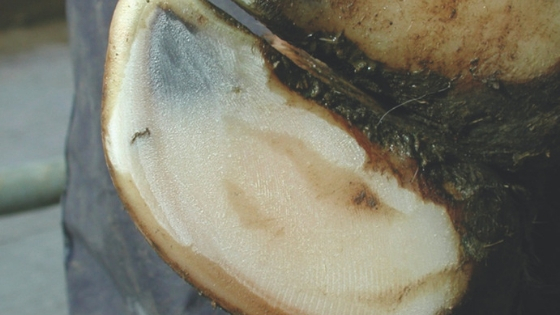
Sole injury is a term used to describe three possible conditions associated with damage to the sole – sole penetration, sole abscess and under-run sole. The following could indicate sole injury:
- Dark hole or crack on sole leading to pocket of pus
- Not always obvious
- Hoof testers usually produce a response over the penetration and the cow will flinch or try to pull away
- In heifers, presentation is often at the toe
Sole bruising
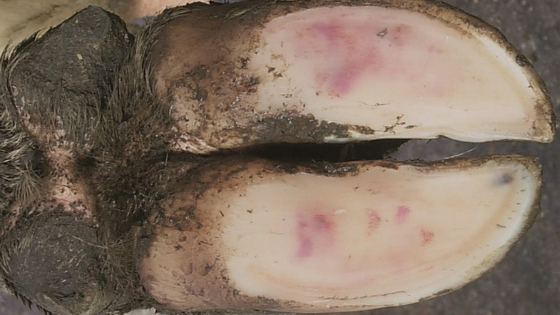
The following could indicate sole bruising:
- The sole has reddish/dark brown areas. Should not be confused with normal pigmentation
- Patches can be localised or they can cover large portions of the sole
- Often the cow is lame in more than one foot
- Cow is often stiff when getting up and walking
This video explains how to treat sole injury or sole bruising.
Preventing lameness
The majority of lameness conditions are preventable. By having good stockmanship, maintaining good laneways and having a good nutrition plan, farmers can significantly reduce lameness.
This section features videos on how to handle stock in a low-stress manner and explains the building blocks of good laneways.
Cow behaviour and stock handling
Understanding cow behaviour
Lameness is commonly the result of a negative alteration in the way cows walk or interact with the herd. In order to prevent lameness, it is critical to first discuss normal cow behaviour.
- Cows need to see where they are placing their feet.
- Subordinate cows will not pass dominant cows.
- Dominant cows will walk throughout the herd, not always at the front.
- Milking order is different to walking order.
- Cows need space in the yard.
- Under pressure, dominant cows push forward using back feet. Lower dominance cows reverse, using front feet to brace and push.
- Cows are creatures of habit.
Good stockmanship
Good stockmanship is another way to help prevent lameness in cows. Cows should not be pressured on the laneway with people, vehicles or dogs.
- Ensure enough cow space in the yard.
- Use the backing gate correctly.
- Movement no longer than five seconds duration.
- Delay first movement until at least two rows or platforms are milked.
- No heads up.
- Use a consistent routine for handling cows.
This video explains cow behaviour and stock handling.
Infrastructure, laneway and milk shed design
Infrastructure
The construction of farm infrastructure is a really important factor in minimising the risk of lameness. Any surface the herd comes into contact with could be a potential risk, so ensuring the best conditions possible is one of the most significant ways to help prevent lameness. The complete guide to preventing and managing lameness gives detailed instructions on building farm infrastructure correctly to minimise lameness.
Laneways
When constructing laneways, it is important to remember that these are high-traffic and transitional areas. Surfaces can easily become uneven or worn over time, with material being carried along from one area to another. Stones, potholes or damp patches can all have adverse affects on hoof condition.
This video on laneway design explains the best ways to minimise lameness.
Yard and milking shed
The most important factor in yard and milking shed design is understanding the movement of the herd through these areas. If the movement of the herd is restricted or uncomfortable at any point, the cows can become unsettled, and the potential for injury increases.
This video explains yard and milking shed design.
Minimising lameness
Cows bunched, heads up
![]()
Heads up suggests the whole herd is too tightly packed. This will result in foot damage from twisting and turning and standing on gravel.
Cows spread out, heads down
Cows need space in the yard. This allows a cow room to manoeuvre gently forward and feel and look for a safe place to stand.
For optimum space, allow at least 1.8 square metres to 2m2 per cow for Holsteins and 1.3m2 for Jerseys.
Cows pushing at an angle with their feet
Cows pushing at an angle with their feet are avoiding pressure from the backing gate or top-gate. Pushing at an angle like this will damage the white line of the foot.
Cows standing upright
When cows are relaxed in the yard, feet are at a normal angle to the yard surface and have a low risk of being damaged.
Rocks and gravel on concrete
Rocks and gravel on concrete damage and penetrate the sole. They are painful to walk on. This results in poor cow flow into the shed
Clean concrete
Clean concrete is less damaging to a cow's foot. Use a nib wall or curb at the junction between gravel and the concrete to prevent gravel being brought onto the yard surface.
Cows bunched up on a laneway
This is caused by herding pressure from behind. Bunching often happens at congestion points in the laneway. The result is poor foot placement and damage to the sole from laneway material.
Cows spread out on a laneway
If cows are spread out and able to drift at their own pace, foot placement is good and wearing of the sole is minimal.
Building stronger hooves
Supplements can help in developing strong, healthy hooves.
The trace minerals copper, selenium, zinc and sulphur are important in the formation of the hoof wall and biotin helps maintain the integrity of the hoof wall. Supplements need to be in the diet for at least four months to have an effect.
Zinc is important in claw horn formation and zinc deficiency has been implicated in lameness in dairy cattle. Zinc is required at 40 to 50 milligrams per kilogram of dry matter. Supplementation with a zinc derivative, such as zinc methionate, has been shown to reduce the incidence of hoof abnormalities.
Copper is required at a level of 10mg per kg of dry matter in the diet of cattle, assuming no interference in uptake of copper.
Biotin contributes to the formation of the hoof wall. Adding biotin to the diet (20mg per cow per day) over a period of 3–4 months has been shown to improve hoof hardness.
Further advice on supplements is available from veterinarians or nutritionists.
Calving and mating care
The fat pad in the cow's hoof acts as a shock absorber. Cows with low body condition will have a thinner cushion which is associated with sole problems and white line disease, especially in heifers. Cows are most likely to lose condition between calving and mating as they adjust to new diets and the demands of lactation.
Hoof trimming
Hoof trimming can be an important strategy to improve claw shape and prevent recurrence of lameness.
The shape of the hoof is a balance between growth and wear. Most cows' hooves grow at approximately 5mm per month. If the wear is less than the growth, overgrowth of the horn leads to incorrect weight bearing. The way in which cows' feet wear depends on their walking surfaces. Hard surfaces such as some laneways and yards can be abrasive and cause excessive wear.
Commonly, the toe wears slower than the heel. The result of this is a cow with longer toes and shallow heels, lowering the hoof angle and putting more pressure on the bottom of the rear pedal bone. In this case, lameness is caused by unbalanced weight bearing leading to more pressure being applied.
What are the risks?
Specialised training is required for functional foot trimming. Inadequately trained people can damage a cow's foot and leave her lame. Common mistakes are:
- Trimming the toe too short and permanently damaging the horn-growing cells
- Removing wall horn, or too much tissue from the inside (medial) heel, causing unstable weight bearing which leads to lameness.
If cows become lame after trimming, promptly:
- Assess the cows
- Have the trimming methods reviewed by skilled practitioners
Limit the spread of infection
It is also important that the foot trimmer follows hygienic procedures in order to limit the spread of infectious lameness conditions, such as digital dermatitis, between cows in the herd or between herds.
Reducing lameness
The prevention, early detection and treatment of lameness improves animal welfare by minimising suffering and distress in cows. The Australian dairy industry is working to minimise the animal welfare impacts of lameness through encouraging the adoption of practices for the prevention, early detection and effective treatment of lameness on farm.
Progress
Dairy Australia has been working with farmers to establish lameness strategies on farm in order to minimise lameness.
Recent survey results report that almost all dairy farmers have implemented a lameness strategy on farm to prevent, identify and treat cases of lameness.
When lameness does occur, dairy farmers follow industry recommendations and inspect the affected hoof in an attempt to identify and address the cause of the problem.
Working on welfare
To continue to provide farmers with the latest information and recommended practices to minimise lameness the dairy industry has worked with local veterinarians to deliver lameness workshops and resources for farmers on the prevention, identification and treatment of lameness.
